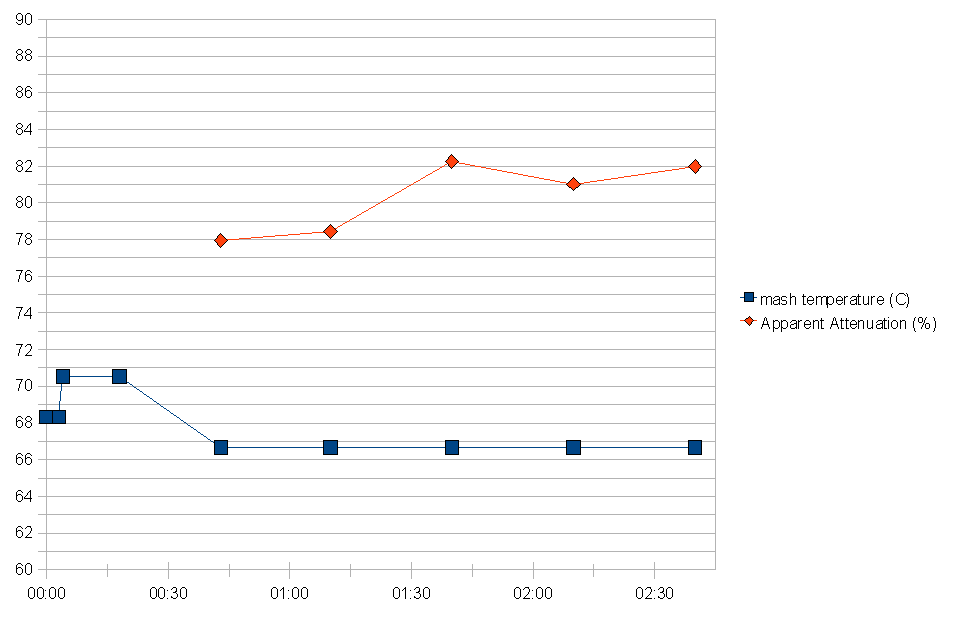Mash Time Dependency of Wort Fermentability
Contents
[hide]Abstract
Does continuing alpha amylase actity after the mash has been converted increase the wort fermentability? The literature suggests that alpha amylase has only little affinity towards shorter chained dextrines which should result in only a small affect on the fermentability of the produced wort. This experiment tries to answer this question.
Theoretical backgound: The Theory of Mashing
Equipment
- 2 Gal cooler as mash tun
- Weyermann Pilsner malt (0.75 kg)
- thermometer
- ladle
- pot for boiling the mash
- strainer and paper towles for latuering the mash
- bottles for fermenting the samples
- lager yeast (Wyeast 2206 from a home brew batch)
- sanitized syringe for measuring the yeast
- oxygenation stone and oxygen bottle
Procedure
The bottles and the funnel are kept in a pot of boiling water. This sanitizes them and keeps the bottles heated so they don't shatter when filled with hot wort.
2.4 l strike water were mixed with the 750g Pilsner malt to reach a mash temperature of 155 *F (68 .3 *C). Since this was lower than the target, 0.2 l boiling water was added after 4 min to get to 159 *F (70.5 *C). A high mash temperature was desired to start out with a mash that is poorly fermentable and is thus able to show any drop in fermentability over time.
The mash pH was measured at about 5.3 with a ColorpHast test strip.
The cooler was placed in an ambient temperature of 170 *F (77 *C) to avoid a temperature drop. But despite this effort the temperature dropped to 152 *F (66.6 *C) before the first sample was taken. After that it remained at that temperature.
Starch conversion was tested with iodine on chalk and after 40 min the mash was iodine negative. At this time the first sample was pulled. 300ml mash were strained into a pot through a strainer. The spent grains were again mixed with 300ml water and strained again. The resulting wort was brought to a boil for 15 min. After the 15 min it was filtered into a bottle through a paper towel. paper towel, strainer and funnel were sanitized in boiling water. Each bottle was capped with aluminum foil. The whole procedure took about 25min for each sample
4 more samples were taken every 30 min. During this time the mash temperature stayed at 152 *F (66.6 *C).
All samples were left to cool for 6 hrs (overnight). Then the original extract was measured for each sample. 5 ml of Wyeast 2206 yeast slurry were injected into each bottle after 10 s of oxygen though an oxygenation stone.
The samples were fermented at room temperature ( ~67 *F / ~19 *C) and shaken occasionally.
After 4 days the samples were fully fermented and their final gravity was measured with a precision hydrometer that has a range of 0.990 - 1.020. All measurements were corrected for temperature and a systematic hydrometer error (determined by measuring the SG of water) as well as converted to degree Plato.
Results
| mash time | original extract (Plato) | final extract (Plato) | Apparent attenuation (%) |
|---|---|---|---|
| 40 min | 10.75 | 2.4 | 77.9 |
| 1 hr 10 min | 11.0 | 2.4 | 78.4 |
| 1 hr 40 min | 13.0 | 2.3 | 82.2 |
| 2 hr 10 min | 12.5 | 2.4 | 81.0 |
| 2 hr 40 min | 11.75 | 2.1 | 82.0 |
Conclusion
Though only a slight one, the mash time shows an affect on the limit of attenuation (fermentability) of the produced wort. Mashing for an additional 2 hrs after conversion is complete increased the apparent attenuation by 4 %. For 12 *P (1.048 OG) wort this means a final extract difference of about 0.5 *P (0.002 SG difference). Though this is not substantial it is significant and could easily result from a stuck sparge or other reason why the targeted mash time was not achieved. Most of this attenuation increase was achieved within the first 90. After that it started to level off. One also needs to account for errors in the measurement since an actual decrease of the fermentability should not have happened. The leveling off can be explained by the reduction of enzymatic activity (heat damage) and the reduced availability of extract that can be converted.
The question now is was it beta or alpha amylase that caused the further reduction of the starches. According to the literature, beta amylase should have been deactivated after the first 10 min at 70 *C (158 *C). If this is true, continued alpha amylase activity was the reason for the continued production of fermentable sugars. Though the drop in mash temperature was unplanned it better emulates the conditions in a real mash, where the temperature starts to drop after a long time. Because of this the brewer should also log the mash time along with the mash temperature profile.
To further validate that alpha amylase is producing fermentable sugars and that an unplanned extension of the mash time can result in missing the attenuation target for the beer, further experiments should be conducted. Such experiments should mash at an even higher temperature (71 - 73 *C) and keep that temperature for the complete mash time to eliminate beta amylase activity as much as possible.
Kai


